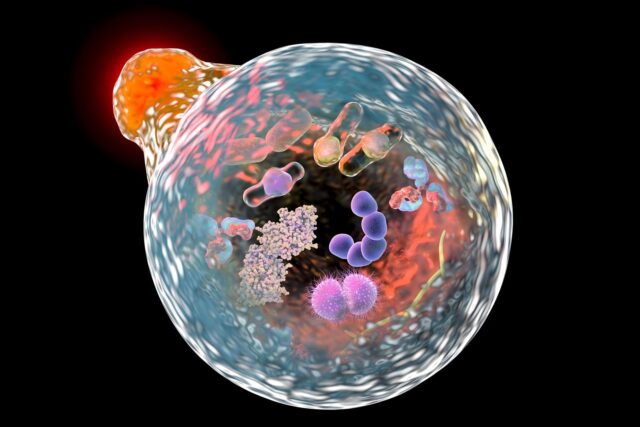The food vacuole is a compartment of the plant cell that contains digestive enzymes. It is created when phagocytosis, or the process of engulfing foreign particles, occurs in plants.
Mitochondria are the organelles that fuse to a food vacuole created after phagocytosis.
The food vacuole will eventually merge with a lysosome, which is the cell’s “recycling center.” Enzymes in lysosomes break down the ingested particle into its basic components (such as amino acids and carbohydrates), which the cell may subsequently utilize.
Do plant cells have food vacuoles in this regard?
In cells, vacuoles are storage bubbles. They can be found in both animal and plant cells, although plant cells are considerably bigger. Vacuoles may store food or any other resources that a cell needs to thrive.
Also, what is the formation of a food vacuole? When food is forced into the cell, the membrane bends inward, forming food vacuoles. The membrane extends inward as the food particle pushes against it, until the food particle is fully within the cell, at which point the membrane pinches off, creating a vacuole. Phagocytosis is the term for this kind of eating.
What is the primary role of the food vacuole in Paramecium in this regard?
Food vacuole is a non-contractile sac that is approximately spherical in form. The size of food vacuoles varies in the endoplasm, and they digest food particles, enzymes, and a tiny quantity of fluid and bacteria. The digestive granules that assist in food digestion are linked with these food vacuoles.
What are the chances of a lysosome fusing with a food vacuole?
The lysosome includes digestive enzymes that aid in the breakdown of food that has been stored in vacuoles. Furthermore, the lysososmes are the sole ones that break down the undigested components. As a result, lysosomes inside a cell fuse with foodvacuoles and transfer digestive enzymes to thevacuole for food digestion.
Answers to Related Questions
What happens if a food vacuole isn’t working properly?
The cell would have no chance of repairing the damage since it would be unable to break down and convert any complicated molecules into what is required. Furthermore, the cell would “starve” since it would be unable to adequately store all nutrients. A plant cell would perish if it didn’t have an avacuole.
What is the primary purpose of a cell’s vacuole?
A cellular organelle present in plant cells is the central vacuole. It is often the cell’s biggest organelle. It is encased in a membrane and serves to collect materials and trash. It also provides structure and support for the developing plant by maintaining the correct pressure inside the plant cells.
In a plant cell, how many vacuoles are there?
There are two responses. Plant cells usually contain one central vacuole that is bigger than the others.
In a cell, how many vacuoles are there?
There is just one vacuole in a plant cell, the Large Central Vacuole. Animal cells do, in fact, have vacuoles. They just have more of them, and other websites refer to them by various names. There is just one vacuole in a plant cell.
What exactly is a food vacuole?
Food vacuole is a membrane-bound vacuole (as in an amoeba) in which ingested food is processed — see image of amoeba.
What are the contents of vacuoles?
Vacuoles are basically confined compartments filled with water holding inorganic and organic molecules in solution, including enzymes, but they may also include solids that have been absorbed in certain instances.
What role does the vacuole play in the plant cell?
The Vacuole’s Purpose All plant and fungal cells, as well as certain protist, animal, and bacterial cells, have a vacuole. These membrane-bound structures are essentially enclosed compartments packed with both inorganic and organic materials, as well as water to keep the organelle alive.
Are there food vacuoles in prokaryotes?
Ribosomes in prokaryotes are made up of a 50S and a 30S component, resulting in a 70S ribosome. Internally bound organelles such as mitochondria, endoplasmic reticulum, Golgi apparatus, vacuoles, and lysosomes are missing. There are no chloroplasts in this organism.
What is the purpose of the food vacuole?
Food Vacuole Function
Food vacuoles are membrane-bound sacs that hold food stuff to be processed inside a cell. Food is kept in these intracellular “stomachs” until it is broken down and nutrients removed.
In biology, what is a contractile vacuole?
Cell Biology is a noun.
Many bacteria have a membrane-enveloped cellular organelle that expands, filling with water, and then contracts, discharging its contents to the cell exterior: believed to be essential in maintaining hydrostatic equilibrium.
What are the most important roles of food?
Basic Nutrient Information (Activity 1.5)
| Nutrient | Functions |
|---|---|
| Carbohydrates | Provide the body with energy. Carbohydrates are divided into three categories: sugar, starch, and fiber. |
| Fats | Provide the body with energy and transport specific vitamins throughout the body. |
In paramecium, how do food vacuoles form?
The food vacuoles in Paramecia are produced by the gullet, which packages the food taken in via the oral groove for digestion.
In amoeba, how do food vacuoles form?
A food vacuole is essentially a food storage unit for amoebae, and it is created only when the amoeba has fully consumed its prey, at which point digestive enzymes are released into the vacuole. After A. proteus eats its prey, it forms a food vacuole.
Is there a distinction between endoplasm and ectoplasm?
The primary distinction between endoplasm and ectoplasm is that endoplasm is the inner, granule-rich, dense component of a cell’s cytoplasm, while ectoplasm is the outer, non-granulated, clear portion.
What is the role of the nucleus in the body?
In eukaryotic cells, the nucleus is an organelle. The bulk of the cell’s genetic material is contained inside its completely encased nuclear membrane. This material is arranged into chromosomes as DNA molecules and a variety of proteins.
What is the function of the nucleus?
This organelle has two purposes: it stores the cell’s genetic material, or DNA, and it controls the cell’s operations, which include growth, intermediate metabolism, protein synthesis, and reproduction (cell division). The cells of sophisticated creatures, known as eukaryotes, are the only ones with a nucleus.
Is the structure of food vacuoles permanent?
Vacuoles may store food or any other resources that a cell needs to thrive. They may also store waste materials in order to keep the remainder of the cell clean. Vacuoles have a rather basic structure. The mass of offluid is surrounded by a membrane.
What is the position of lysosomes in the body?
Lysosomes are found in almost all animal cells (excluding RBCs), particularly in the liver, spleen, and kidney cells, as well as immune system cells such as macrophages and polymorphonuclear leukocytes. Lysosomes are tiny, spherical, membrane-bound vesicles (about 1 mm in diameter) that contain strong digesting enzymes.
The lysosomes are involved in is a food vacuole created after phagocytosis. It is the organelle that fuses with the food vacuole.
Frequently Asked Questions
What organelle fuses with the food vacuole?
The food vacuole fuses with the lysosome, which is a cells digestive organelle.
What does a food vacuole fuse with?
What membrane-bound organelle is formed after phagocytosis?
The vacuole is a membrane-bound organelle that forms after phagocytosis.
Related Tags
- pinocytosis
- golgi apparatus function
- peroxisome function




